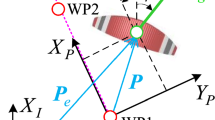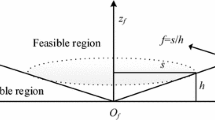Abstract
The utilization of parafoil systems in both military and civilian domains exhibits a high degree of application potential, owing to their remarkable load-carrying capacity, consistent flight dynamics, and extended flight endurance. The performance and safety of powered parafoils during the flight are directly contingent upon the efficacy of the control system employed. For powered parafoils, the direction is controlled by steering ropes connecting to the edges of the parafoil canopy. And a propeller attached to the back of the payload controls the flight height. However, strong couplings exist between two control channels, which makes controlling powered parafoil systems challenging, especially under wind disturbances. This paper aims to address these challenges by proposing a three-dimensional (3D) path-following control method for powered parafoils. To this end, the lateral and altitude path-following controllers were designed to solve this problem based on linear active disturbance rejection control (LADRC) with disturbance rejection and decoupling features. Furthermore, the adaptive parameters of these two controllers were obtained through the implementation of deep deterministic policy gradient (DDPG). The efficacy of the proposed DDPG-LADRC approach was then evaluated through simulations of 3D path tracking, including both straight and circular paths, while also taking into account wind disturbances to assess its anti-disturbance capability. The results of these simulations indicate that the proposed method effectively realizes the 3D path following control of powered parafoils.










Similar content being viewed by others
Data Availability Statement
Data sharing not applicable to this article as no datasets were generated or analysed during the current study.
References
Zhu, H., Sun, Q., Liu, X., Liu, J., Sun, H., Wu, W., Tan, P., Chen, Z.: Fluid-structure interaction-based aerodynamic modeling for flight dynamics simulation of parafoil system. Nonlinear Dyn. 104, 3445–3466 (2021)
Sun, Q., Yu, L., Zheng, Y., Tao, J., Sun, H.: Trajectory tracking control of powered parafoil system based on sliding mode control in a complex environment. Aerosp. Sci. Technol. 122, 107406 (2022)
Calise, A.J., Preston, D.: Swarming/flocking and collision avoidance for mass airdrop of autonomous guided parafoils. J. Guid. Control. Dyn. 31(4), 1123–1132 (2008)
Jann, T.: Aerodynamic model identification and GNC design for the parafoil-load system ALEX. In 16th AIAA Aerodynamic Decelerator Systems Technology Conference and Seminar (2015)
Slegers, N., Costello, M.: Model predictive control of a parafoil and payload system. J. Guid. Control. Dyn. 28(4), 816–821 (2005)
Tan, P., Sun, M., Sun, Q., Chen, Z.: Dynamic modeling and experimental verification of powered parafoil with two suspending points. IEEE Access 8, 12955–12966 (2020)
Guo, Y., Yan, J., Wu, C., Xiao, B.: Modeling and practical fixed-time attitude tracking control of a paraglider recovery system. ISA Trans. 128, 391–401 (2021)
Zhu, E., Sun, Q., Tan, P., Chen, Z.: Modeling of powered parafoil based on Kirchhoff motion equation. Nonlinear Dyn. 79, 617–629 (2015)
Tao, J., Sun, Q., Liang, W., Chen, Z.: Computational fluid dynamics based dynamic modeling of parafoil system. Appl. Math. Model. 54, 136–150 (2018)
Tao, J., Dehmer, M., Xie, G., Zhou, Q.: A generalized predictive control-based path following method for parafoil systems in wind environment. IEEE Access 7, 42586–42595 (2019)
Zhao, L., He, W., Lv, F.: Model-free adaptive control for parafoil systems based on the iterative feedback tuning method. IEEE Access 9, 35900–35914 (2021)
Guo, Y., Yan, J., Wu, C., Wu, X., Chen, M., Xing, X.: Autonomous homing design and following for parafoil/rocket system with high-altitude. J. Intell. Robot. Syst. 101(73), 1–15 (2021)
Tao, J., Sun, Q., Sun, H., Chen, Z., Dehmer, M., Sun, M.: Dynamic modeling and trajectory tracking control of parafoil system in wind environment. IEEE/ASME Trans. Mechatron. 22(6), 2736–2745 (2017)
Luo, S., Sun, Q., Sun, M., Pan, T., Wu, W., Sun, H., Chen, Z.: On decoupling trajectory tracking control of unmanned powered parafoil using ADRC-based coupling analysis and dynamic feedforward compensation. Nonlinear Dyn. 92, 1619–1635 (2018)
Han, J.: From PID to active disturbance rejection control. IEEE Trans. Ind. Electron. 56(3), 900–906 (2009)
Han, J.: Auto-disturbance-rejection controller and its applications. Control Decis. 01, 19–23 (1998)
Gao, Z.: On the foundation of active disturbance rejection control. Control Theory Appl. 30, 1498–1510 (2013)
Lin, P., Wu, Z., Fei, Z., Sun, X.: A generalized PID interpretation for high-order LADRC and cascade LADRC for servo systems. IEEE Trans. Ind. Electron. 69(5), 5207–5214 (2021)
Cai, Z., Wand, Z., Zhao, J., Wang, Y.: Equivalence of LADRC and INDI controllers for improvement of LADRC in practical applications. ISA Trans. 126, 562–573 (2021)
Tao, J., Du, L., Dehmer, M., Wen, Y.: Path following control for towing system of cylindrical drilling platform in presence of disturbances and uncertainties. ISA Trans. 95, 185–193 (2019)
Zheng, Y., Tao, J., Sun, Q., Hao, H., Sun, M.: An intelligent course keeping active disturbance rejection controller based on double deep Q-network for towing system of unpowered cylindrical drilling platform. Int. J. Robust Nonlinear Control 31, 8463–8480 (2021)
Wang, Z., Zhao, T.: Based on robust sliding mode and linear active disturbance rejection control for attitude of quadrotor load UAV. Nonlinear Dyn. 108, 3485–3503 (2022)
Wang, Y., Liu, J., Chen, Z., Sun, M.: On the stability and convergence rate analysis for the nonlinear uncertain systems based upon active disturbance rejection control. Int. J. Robust Nonlinear Control 30, 5728–5750 (2020)
Xu, B., Cheng, Z., Zhang, R., Gong, C., Huang, L.: PSO optimization of LADRC for the stabilization of a quad-rotor. In 2020 12th International Conference on Measuring Technology and Mechatronics Automation (ICMTMA), Phuket, Thailand, 28–29 February (2020)
Huang, Z., Chen, Z., Zheng, Y., Sun, M., Sun, Q.: Optimal design of load frequency active disturbance rejection control via double-chains quantum genetic algorithm. Neural Comput. Appl. 33, 3325–3345 (2021)
Zheng, Y., Huang, Z., Tao, J., Sun, H.: A novel chaotic fractional-order beetle swarm optimization algorithm and its application for load-frequency active disturbance rejection control. IEEE Trans. Circuits Syst. II Express Briefs 69(3), 1267–1271 (2021)
Roman, R., Precup, R., Petriu, E.M.: Hybrid data-driven fuzzy active disturbance rejection control for tower crane systems. Eur. J. Control. 58, 373–387 (2021)
Wang, S., Zhu, H., Wu, M.: Active disturbance rejection decoupling control for three-degree-of-freedom six-pole active magnetic bearing based on bp neural network. IEEE Trans. Appl. Supercond. 30, 3603505 (2020)
Zhao, L., He, W., Lv, F.: Trajectory tracking control for parafoil systems based on the model-free adaptive control method. IEEE Access 8, 152620–152636 (2020)
Watkins, C.J.C.H., Dayan, P.: Q-learning. Mach. Learn. 8, 279–292 (1992)
Pan, J., Wang, X., Cheng, Y., Yu, Q.: Multisource transfer double DQN based on actor learning. IEEE Trans. Neural Netw. Learn. Syst. 29(6), 2227–2238 (2018)
Hou, Y., Liu, L., Wei, Q., Xu, X., Chen, C.: A novel DDPG method with prioritized experience replay. In 2017 IEEE International Conference on Systems, Man, and Cybernetics (SMC), Banff, AB, Canada, 5–8 October (2017)
Liu, Y., Huang, C.: DDPG-based adaptive robust tracking control for aerial manipulators with decoupling approach. IEEE Trans. Cybern. 52(8), 8258–8271 (2021)
Li, L., Xu, H., Ma, J., Zhou, A., Liu, J.: Joint EH time and transmit power optimization based on DDPG for EH communications. IEEE Commun. Lett. 24(9), 2043–2046 (2020)
Yu, Z., Tan, P., Sun, Q.: Longitudinal wind field prediction based on DDPG. Neural Comput. Appl. 34, 227–239 (2022)
Qin, H., Tan, P., Chen, Z., Sun, M., Sun, Q.: Deep reinforcement learning based active disturbance rejection control for ship course control. Neurocomputing 484, 99–108 (2022)
Funding
This work was supported by the National Natural Science Foundation of China [Grant Numbers 61973172, 61973175, 62003175, 62003177, and 62073177], the National Key Research and Development Project [Grant Number 2019YFC1510900], and the Key Technologies Research and Development Program of Tianjin [Grant Number 19JCZDJC32800]. This project was also funded by China Postdoctoral Science Foundation [Grant Number 2020M670633] and the Tianjin Research Innovation Project for Postgraduate Students [2021YJSB084]. We thank LetPub (www.letpub.com) for its linguistic assistance during the preparation of this manuscript.
Author information
Authors and Affiliations
Contributions
All authors contributed to the study conception and design. Formal analysis, Software and visualization were performed by YZ. Validation, writing-review & editing were performed by QS, XZ and HS. The first draft of the manuscript was written by YZ and JT. Conceptualization was performed by MS and ZC. Supervision was performed by XZ. And all authors commented on previous versions of the manuscript. All authors read and approved the final manuscript.
Corresponding authors
Ethics declarations
Conflict of interest
The authors have no relevant financial or non-financial interest to disclose.
Additional information
Publisher's Note
Springer Nature remains neutral with regard to jurisdictional claims in published maps and institutional affiliations.
Rights and permissions
Springer Nature or its licensor (e.g. a society or other partner) holds exclusive rights to this article under a publishing agreement with the author(s) or other rightsholder(s); author self-archiving of the accepted manuscript version of this article is solely governed by the terms of such publishing agreement and applicable law.
About this article
Cite this article
Zheng, Y., Tao, J., Sun, Q. et al. DDPG-based active disturbance rejection 3D path-following control for powered parafoil under wind disturbances. Nonlinear Dyn 111, 11205–11221 (2023). https://doi.org/10.1007/s11071-023-08444-4
Received:
Accepted:
Published:
Issue Date:
DOI: https://doi.org/10.1007/s11071-023-08444-4




